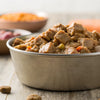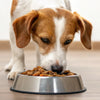Should You Feed Your Dog Dry or Wet Food? Understanding the Best Choice for Your Pup
- Houndsy
Table of Contents
- Introduction
- Understanding Dog Food Basics
- Pros and Cons: Wet vs. Dry Dog Food
- Mixing Wet and Dry Dog Food
- Transitioning Your Dog's Diet
- Real-Life Scenarios: Choosing the Best Food
- Conclusion
- FAQs
Introduction
Did you know that nearly 60% of dog owners often grapple with the question of whether to feed their furry friends dry food or wet food? As dedicated pet lovers, we want the best for our canine companions, and choosing the right diet is crucial to their health and happiness. With abundant options in pet food aisles, navigating the pros and cons of dry versus wet food can feel overwhelming.
This blog post aims to demystify the topic by exploring the fundamental differences between dry and wet dog food, their respective benefits and drawbacks, and how to choose the right diet for your dog. By the end, you'll have a clearer understanding of what works best for your pet's unique needs and preferences, helping you make informed feeding choices that enhance their daily experience.
We'll discuss the nutritional profiles of both feeding options, their impact on your dog's health, and practical considerations in daily feeding routines. Consider reflecting on your dog's habits while reading—do they prefer one type over the other? Are there specific health concerns we should address? Let’s dive in!
Understanding Dog Food Basics
The Composition of Dog Food
Regardless of whether you opt for dry kibble or wet food, the primary goal is to provide your dog with a nutritionally balanced diet. Both types can effectively meet your pet's dietary needs, provided they come from reputable brands. Understanding what goes into these foods is essential for making an informed decision.
Dry Dog Food: Often referred to as kibble, dry dog food typically contains a mix of meat, grains, vegetables, and added vitamins and minerals. The process involves cooking the ingredients into a dough, which is then extruded into dry pellets and baked. This form of food generally contains about 10-12% moisture and is packed with essential nutrients.
Wet Dog Food: Also known as canned food, wet dog food contains higher moisture content—around 75-80%. The ingredients are cooked and sealed in a can to retain moisture and flavor. While they also comprise a blend of proteins, grains, and vegetables, wet foods are often more appealing to dogs due to their aroma and texture.
Both feeding options offer unique advantages, but what works for one dog might not suit another. Factors such as your dog's age, health condition, preferences, and lifestyle play a significant role in determining the best choice.
Pros and Cons: Wet vs. Dry Dog Food
Benefits of Wet Dog Food
-
High Moisture Content: Wet food can help keep your dog hydrated, especially crucial for dogs that may not drink enough water. This can be particularly beneficial for dogs with urinary or kidney concerns.
-
Palatability: Many dogs find wet food more appetizing due to its richer aroma and flavor. Picky eaters or older dogs who may have diminished senses often show increased interest in wet food.
-
Easier to Chew: Soft textures make wet food an excellent choice for dogs with dental issues, senior canines, or those recovering from surgeries.
-
Increased Satiety: Wet food creates a feeling of fullness, which can aid in weight management. If your dog tends to overeat, the filling nature of wet food might help regulate their appetite.
-
Ideal for Mixing Medications: If your dog is on medication, it can be easier to mix pills into wet food than dry, making it a great option for administering treatments.
Drawbacks of Wet Dog Food
-
Shorter Shelf Life: Once opened, canned food must be refrigerated and consumed within a few days to prevent spoilage.
-
Higher Cost: Wet food is generally more expensive than dry kibble, primarily due to its packaging and moisture content.
-
Messy: Serving wet food can be messier than dry kibble, often leading to food residue sticking to your dog’s fur and the feeding area.
-
Limited Portion Control: Wet food often comes pre-portioned in cans, making it difficult to adjust serving sizes precisely for your dog's requirements.
Benefits of Dry Dog Food
-
Convenience: Dry food is easier to store and serve. It can be left out for longer periods without spoiling, making it great for dogs who like to graze.
-
Dental Health: Chewing dry kibble can help reduce plaque and tartar buildup, promoting dental health.
-
Cost-Effective: Generally, dry dog food is less expensive than wet food, which can lead to savings over time, especially if you're buying in bulk.
-
Longer Shelf Life: Dry food can often be stored for longer periods without spoiling, making it a convenient pantry staple.
-
Food Enrichment: Kibble can be utilized in food puzzles or enrichment activities, providing mental stimulation for your dog.
Drawbacks of Dry Dog Food
-
Lower Moisture Content: Dogs that tend to drink less water may become dehydrated if primarily fed dry food, which can lead to health issues.
-
Picky Eaters: Some dogs may find dry kibble less appealing than wet food, particularly if they are accustomed to a richer taste.
-
Potential Preservatives: Some cheaper brands may include preservatives and fillers that you may want to avoid.
Mixing Wet and Dry Dog Food
For those torn between wet and dry food, blending both may be an excellent solution, balancing the benefits of each. We should consider a few aspects when thinking about mixing diets:
-
Nutritional Balance: Ensure that both wet and dry foods are complete and balanced, providing adequate nutrition for your dog’s specific life stage and lifestyle.
-
Portion Control: Mixing diets requires careful monitoring of portions to avoid overfeeding. It’s critical to adjust the overall caloric intake accordingly.
-
Texture and Variety: Some dogs appreciate variety in their meals, and mixing textures can keep mealtime exciting.
-
Veterinary Guidance: If unsure about the right proportions of each type of food, consulting with a veterinarian can provide tailored recommendations.
Transitioning Your Dog's Diet
When changing your dog's diet, gradual transitions are essential to prevent digestive upset. Whether switching to wet food, dry food, or a combination, follow these general steps:
-
Start Slowly: Introduce new food into your dog's current diet over 5 to 7 days, increasing the proportion of new food gradually.
-
Observe Reactions: Monitor your dog for any digestive issues or changes in appetite as you transition. Look for signs of discomfort, vomiting, or diarrhea.
-
Consult Your Veterinarian: If you notice adverse reactions or if your dog has specific dietary needs, be sure to consult your veterinarian.
Real-Life Scenarios: Choosing the Best Food
Consider a couple of hypotheticals to illustrate how individual circumstances can influence food choice:
-
Scenario 1: Senior Slimmer
Our friend Max, an older Labrador, is getting a little thin and reluctant to eat. His owner decides to transition to wet food to stimulate his appetite and ensure he’s getting adequate hydration. It turns out to be the perfect switch—Max starts licking his bowl clean again! -
Scenario 2: Active Pup
Then there's Bella, a high-energy German Shepherd who loves to run and explore. Her owner prefers dry kibble, which fits perfectly into their busy schedule. Bella's dental health benefits from the crunchiness, and she can graze throughout the day without her food spoiling.
Conclusion
In the debate over whether you should feed your dog dry or wet food, there is no one-size-fits-all answer. Each type of food offers distinct benefits and potential drawbacks, with the best choice often depending on individual factors such as your dog's lifestyle, preferences, and any specific health considerations.
Understanding the pros and cons of dry versus wet food empowers us as responsible pet owners to optimize our pups' feeding routines and make choices that enhance their quality of life. So, whether you choose the crunch of kibble, the smoothness of pâté, or a delightful mix of both, your dog will thrive with the right nutrition tailored to their needs.
As you navigate these choices, consider how our products can enhance your feeding experience—check out the Houndsy Kibble Dispenser, designed to simplify and elevate your dog-feeding ritual. Explore the Houndsy Kibble Dispenser here!
FAQs
1. Can I switch my dog’s food suddenly?
It’s best to transition gradually by mixing the new food with the old over a week or so to avoid stomach upset.
2. How can I ensure my dog is getting enough hydration?
If feeding dry food, ensure fresh water is always available, or consider mixing in wet food for added moisture.
3. Is it safe to feed my dog both wet and dry food?
Yes, many dog owners successfully feed a mix of both! Just be sure to monitor portions to maintain a balanced diet.
4. What signs should I look for to know if my dog isn’t adjusting well to a new food?
Watch for diarrhea, vomiting, or a lack of appetite. If these occur, consult your veterinarian.
5. Do certain breeds have preferences for wet vs dry food?
Yes, some breeds may show preference for one over the other, often determined by texture, taste, and individual habits.
By blending knowledge with compassion, we create a happier, healthier feeding experience for our beloved companions. Remember, whichever diet you choose—it's about what works best for you and your pup!












